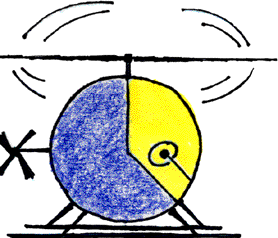

Little Helicopters
Introduction
Helicopters are types of aircraft whose aerodynamic support is obtained chiefly from propellers rotating on a vertical axis. The following lesson is adapted from several sources using a similar design for constructing little, paper helicopters. These little helicopters spin and float gently to the ground. When the little helicopters fall, the air pushes up against the paper blades. This causes them to bend a bit. Some of the thrust creates a horizontal push, forcing air upwards against the blades. There are two blades at work and each one receives the same push in opposite directions. This makes the little helicopters spin.
Connections
The State of California Science Content Standards calls for Grade 2 Physical Science students to know that the motion of objects can be observed and measured. As a basis for understanding this concept, in this lesson students will learn how an object's motion can be described by recording the change in its postion over time. Students will also know that objects near the Earth fall to the ground unless something holds them up. Additionally, the Investigations and Experimentation strand calls for students to follow verbal instructions, make predictions, take measurements, record data, and construct bar graphs. All these standards and more are reflected in this lesson. There may be other applications for this lesson at other grade levels. However, it makes the best match for second grade instruction of the physical sciences. (adapted from the State of California Science Content Standards, Grade 2, Physical Sciences: 1.b., 1.e., 4.a., 4.b., 4.e., and 4.g.)
Task
Construct 3 little, paper helicopters and drop them from different heights, predict the helicopters with the longest and shortest flight times, measure the flight times, record data and construct bar graphs. Follow these simple procedures. Let's get started!
Extensions
For more information to support this investigative activity go to the Queensland Sciencentre. Click on "Young Scientist", then click "Do & Discover". Here you will find a similar activity and many others like it that will provide you with hours of experimental fun.
Visit "The K-8 Aeronautic Internet Textbook" at UCDavis. Go to the "Principles of Aeronautics, choose your reading level, and have some fun exploring the world of flight and aeronautics. Here you will find more activities and experiments, selected readings, and background information on basic flight principles and aeronautics. Of special interest at this site are the options: "Read It To Me", Spanish language, and leveled reading options. The link for this site is set to the beginner level.
Check out the Exploratorium's "Science Explorer" section, which has many activities available on its website that will provide you with instructional and investigative opportunities for young students. Check out the "Roto-Copter" to find additional activities for your little paper helicopters.
System Requirements
Java enabled browser, Netscape 3.0 or better or Explorer 3.0 or better